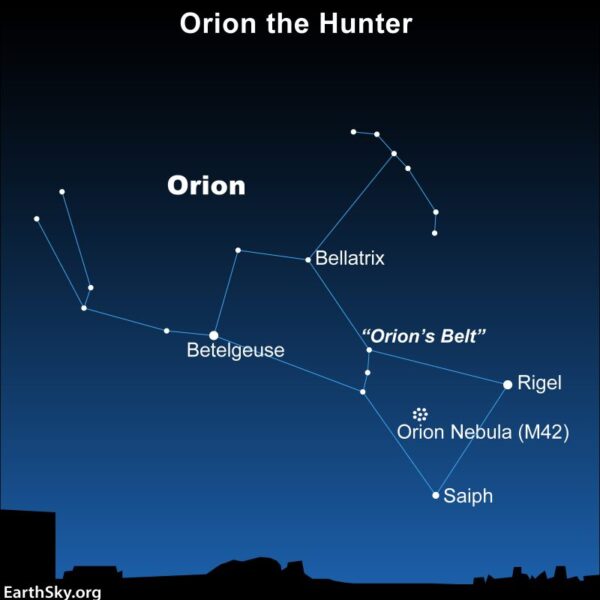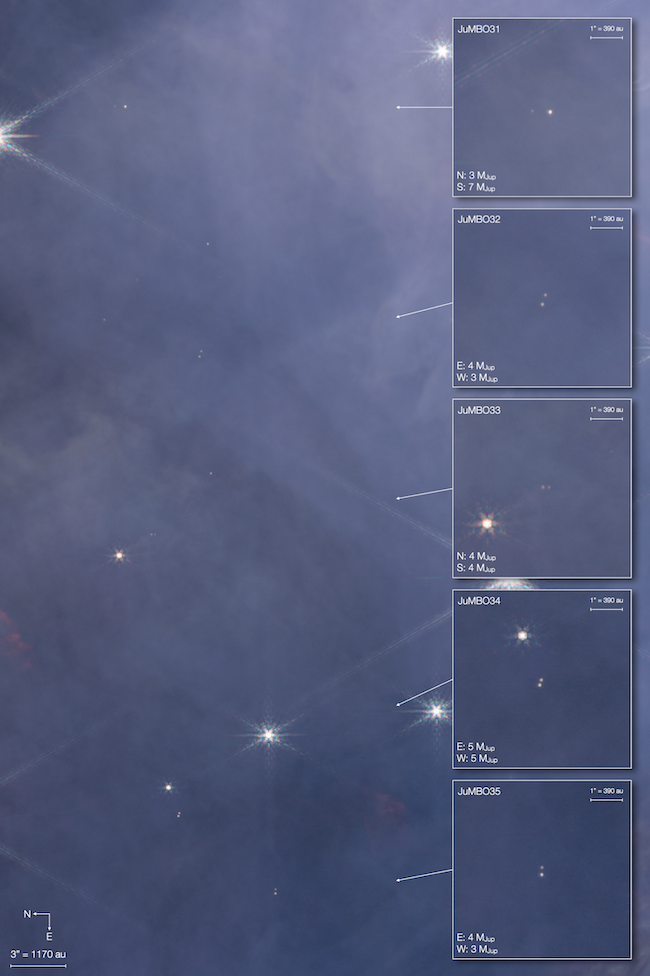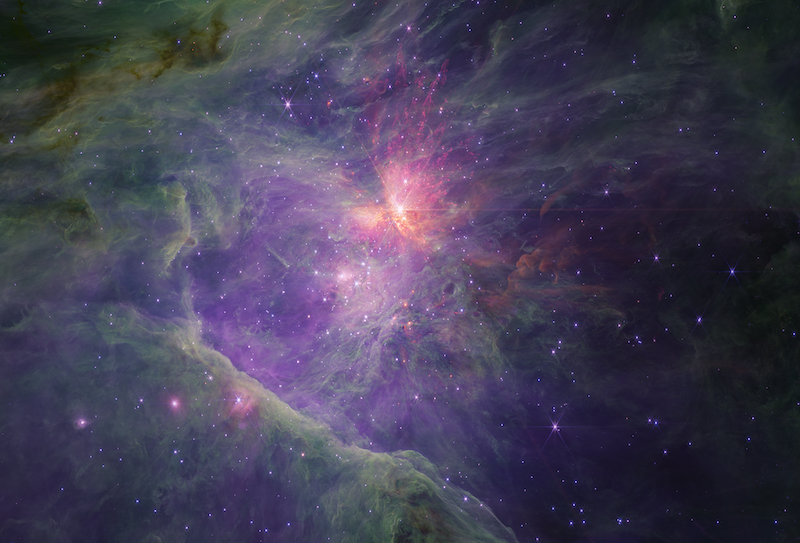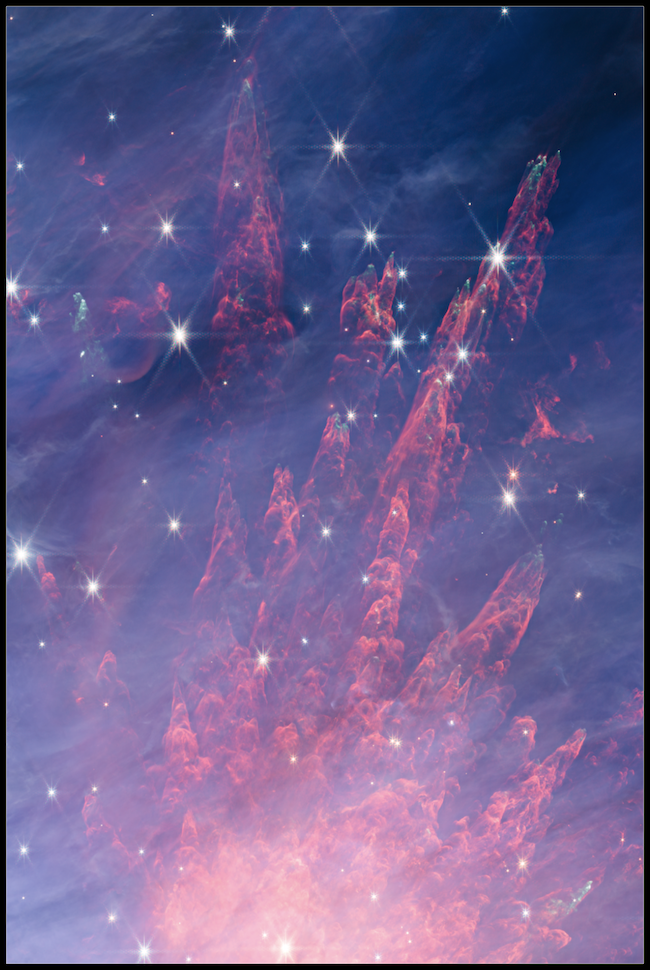Late December and January are a grand time to view the constellation Orion the Hunter. It’s recognizable for Orion’s three Belt stars, three medium-bright stars in a short, straight row. When you see Orion, think about these recent images from the James Webb Space Telescope of the star-forming Orion Nebula. Scientists released the images in the fall of 2023. The images showcase the inner portions of the famous nebula, including the hot young stars in the Trapezium Cluster. The two mosaics are among the largest obtained so far by Webb. They show intricate details of dust, gas, stars and protoplanetary disks within the nebula. They are included in the ESASky application, where you can explore and download the images.
The 2024 lunar calendars are here! Makes a great New Years gift. Check ’em out here.

JuMBOs in the Orion Nebula
The new images also revealed something new and unexpected: large planet-mass objects drifting on their own inside the nebula. Indeed, astronomers have discovered a growing number of rogue planets floating in our galaxy in interstellar space, unbound to any stars. Some of these objects, however, are rather peculiar. Surprisingly, these ones are binary, drifting in pairs. How did that happen? Astronomers are calling them Jupiter Mass Binary Objects, or “JuMBOs.” Current theories of planet and star formation say they shouldn’t exist. Yet they do. As co-lead author Samuel Pearson at the European Space Agency (ESA) told The New York Times:
There’s something wrong with either our understanding of planet formation, star formation or both. They shouldn’t exist.
There is a preprint version of the paper available, published on arXiv on October 2, 2023. Both this preprint as well as a preprint of the other paper covering the overall Webb survey of the Orion Nebula are also available on the website of the other co-lead author, Mark McCaughrean at ESA.
Kind of like planets, but not planets
Altogether, Webb found 540 planetary mass objects in the Orion Nebula, which is 1,344 light years from Earth. They range from about the mass of Jupiter down to only 0.6 Jupiter masses. Of the 540, the JuMBOs are the most intriguing. They are not just single objects moving through space by themselves. Rather, they are pairs of objects.
Scientists with the Webb mission say the objects are gassy, similar to gas giant planets. But technically, they aren’t planets since they don’t orbit stars. They have surface temperatures of about 1,000 degrees Celsius (1,800 degrees Fahrenheit). Moreover, they are also quite young in cosmic terms, only about an estimated one million years old. While the objects are in pairs, they aren’t really that close to each other. In each binary, or JuMBO, the objects orbit each other and are separated by about 200 times the distance between the Earth and sun. Each orbit takes 20,000 years to complete.

How do JuMBOs form?
So where did they come from? How did they form? Physics says it would be difficult for such objects to form on their own in open space away from any stars. One theory is that they formed in regions of the nebula where there wasn’t enough material to create larger stars. Some smaller objects, like planets and brown dwarfs, can form through a process similar to stars, where gas and dust collapse under their own gravity. Theoretical predictions, however, suggest that the lower boundary for an object forming through such a gravitational collapse is about three to seven Jupiter masses. These objects are notably smaller than that.
Ejected rogue planets?
The other theory, the one favored at the moment, is that they did originally form around stars, but were ejected into deep space. Indeed, single planets can be ejected from their star systems, which is where other rogue planets are thought to come from. But pairs of planets? That hasn’t been seen before … until now. McCaughrean told BBC News:
Gas physics suggests you shouldn’t be able to make objects with the mass of Jupiter on their own, and we know single planets can get kicked out from star systems. But how do you kick out pairs of these things together? Right now, we don’t have an answer. It’s one for the theoreticians.


Elsewhere in the Orion Nebula
The new images also show much more than just the JuMBOs. Webb’s near-infrared camera, NIRCam, captured the stunning new views of the Orion Nebula. The first mosaic is composed of data from the short wavelength channel, and the second uses data from the long wavelength channel.
Overall, a rich variety of objects can be seen – apart from just the JuMBOs – including planet-forming disks around young stars, embedded protostars, brown dwarfs and photodissociation regions. Those are interface regions where the radiation from the massive stars heats, shapes and influences the chemistry of the gas. These are some of the largest mosaics that Webb has produced so far. The short wavelength mosaic reveals beautiful details in planetary disks and outflows, while the long wavelength mosaic shows an intricate network of dust and organic compounds called polycyclic aromatic hydrocarbons.
The Orion Nebula is a stellar nursery, where new stars and planets are being born. Last June, astronomers said that they discovered the carbon compound known as methyl cation in the nebula. This compound is important, because it aids the formation of more complex carbon-based molecules. Those include ones that make up our human bodies and the bodies of other living things. Clearly, the Orion Nebula is not only beautiful to look at, it is also full of mysteries and new discoveries.
Bottom line: The James Webb Space Telescope has discovered something unexpected in the Orion Nebula: pairs of unusual planet-like “binary objects” drifting freely in space. How did they get there?
Source (preprint): Jupiter Mass Binary Objects in the Trapezium Cluster
Source (preprint): A JWST survey of the Trapezium Cluster & inner Orion Nebula
Via:
The New York Times
BBC
ESA
Read more: Are there more rogue planets than stars in our galaxy?
Read more: Fly through the Orion Nebula